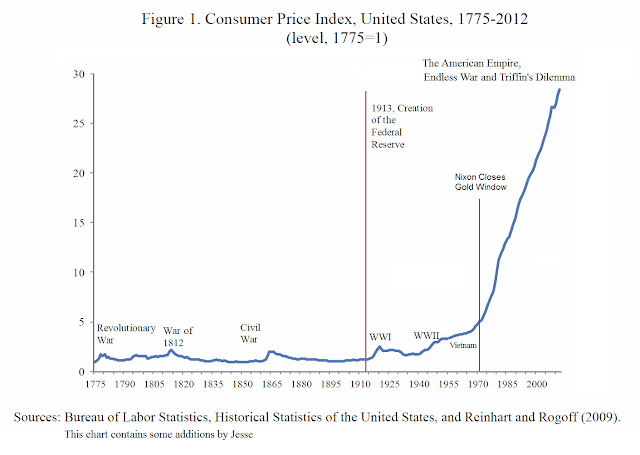Please notice that the CPI really 'gets some legs' when Nixon closed the gold window and released the modern monetary theory from its next to last restraint, the bond vigilantes being the last thin blue line.
And below that a quote on the modern monetary system, in which I detect the root of Paul Krugman's confusion about money.
To his credit, Krugman does recognize the liquidity trap, which sets him head and shoulders apart from the Austerians. He just does not understand the markets and how they work in practice rather than theory, and the absolutely compelling need for reform. But that puts him in with most regulators, central bankers, and the herd of academic economists.
Shifting Mandates: The Federal Reserve’s First Centennial
Carmen M. Reinhart and Kenneth S. Rogoff
For presentation at the American Economic Association Meetings, San Diego,
January 5, 2013
Session: Reflections on the 100th Anniversary of the Federal Reserve
Read the entire paper in PDF form here.
h/t Bill P and Business Insider

"The current world monetary system assigns no special role to gold; indeed, the Federal Reserve is not obliged to tie the dollar to anything. It can print as much or as little money as it deems appropriate [History suggests that while they technically can print as much as they wish, there is an effective upper bound along with a law of diminishing returns in there somewhere. Weimar and John Law, amongst others, tended to show that. - Jesse]
There are powerful advantages to such an unconstrained system. Above all, the Fed is free to respond to actual or threatened recessions by pumping in money. To take only one example, that flexibility is the reason the stock market crash of 1987—which started out every bit as frightening as that of 1929—did not cause a slump in the real economy.
While a freely floating national money has advantages, however, it also has risks. For one thing, it can create uncertainties for international traders and investors. Over the past five years, the dollar has been worth as much as 120 yen and as little as 80.
The costs of this volatility are hard to measure (partly because sophisticated financial markets allow businesses to hedge much of that risk) [O brave New World, that has such derivative sophisticates in it. - Jesse] but they must be significant. Furthermore, a system that leaves monetary managers free to do good also leaves them free to be irresponsible—and, in some countries, they have been quick to take the opportunity." [Yes, THOSE countries may experience a financial collapse because of a monetary credit bubble, no doubt because of a lack of economic sophisticates. - Jesse]
Paul Krugman, The Goldbug Variations, 22 November 1996































